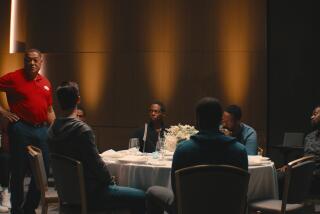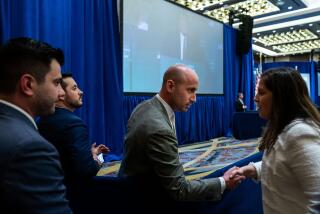Boycotts a Touchy Business for Targeted Firms
When a group of sports bar owners led by a San Diego hot dog vendor threatened to mount a national boycott of network sponsors over plans of CBS and NBC to scramble their satellite transmissions of professional football games, the two networks promptly gave in, at least for this season.
The networks’ capitulation last week to the noisy interest group--and to network advertisers including Anheuser-Busch and the Miller Brewing Co., whose businesses could be damaged by the boycott--reflects a new willingness on the part of corporations to respond to proliferating consumer boycott movements like that of the sports bar owners.
“It used to take years for companies to even recognize that they were being boycotted,” said Todd Putnam, editor of the Seattle-based National Boycott News, a 6-year-old publication that tracks consumer protests. “Companies are becoming more defensive” than they used to be.
Putnam attributes companies’ growing sensitivity to product boycotts to sheer numbers. There are more than 70 groups around the country now sponsoring or co-sponsoring 200 to 300 boycotts, twice as many as were being mounted this time a year ago. Heightened environmental awareness is the motive behind most of the consumer movements, he added.
“1990 is shaping up to me to be the year of the boycott,” he said.
Leader of the sports bar boycott was Norman Lebovitz, owner of Sluggo’s, a San Diego hot dog eatery that features satellite broadcasts of Chicago professional sports games. He said the networks’ plan, announced last month, to scramble National Football League broadcasts would have seriously damaged his restaurant’s business.
Lebovitz quickly enlisted the support of hundreds of other sports bar owners nationwide who were in the same predicament and threatened to boycott the products of several NFL network sponsors, including Anheuser-Busch, Miller and Sears, Roebuck & Co.
Miller was concerned enough about the prospect of a boycott to fly Lebovitz to New York to meet with network executives, an example of what Miller spokesman Dave Fogelson says is his company’s willingness to listen to the concerns of its customers and retailers.
“We consider what they say, and we respond accordingly,” Fogelson said. “But the response isn’t always going to be the same.”
Lebovitz said he was relieved when the networks said last week that they were suspending NFL scrambling until next year at the earliest. “My heart wasn’t really in this. Being a retailer all my life, I really had no desire to hurt anybody,” Lebovitz said.
The cancellation of the plans to scramble broadcast signals became more or less official Monday, when NFL Commissioner Paul Tagliabue declared in a letter to U.S. Rep. Jim Bates (D-San Diego) that “there will be no scrambling of these signals during this season.” Bates has said he is considering introducing a bill to prevent the NFL from scrambling.
Responding to such threats does not always mean that the companies are giving in. Nike demonstrated that with its defiant posture in the face of Operation PUSH’s recently announced boycott of Nike’s shoe and sportswear. Nike claimed that the civil rights group had been influenced by donations from its leading competitor, Reebok International. Operation PUSH denied the charge.
Boycotting has become so legitimate that even corporations are using it. Earlier this year, Procter & Gamble canceled all advertising with a Boston TV station, WHDH-TV, after the station carried advertisements produced by Neighbor to Neighbor, a San Francisco-based group, that urged viewers not to buy Folgers coffee, a P&G; subsidiary. The ads criticized Folgers for using Salvadoran beans.
Don Tassone, a spokesman for P&G;, said his company believes in the right of groups like Neighbor to Neighbor to protest corporate actions and even to mount boycotts. “But this was a very offensive piece of advertising,” he said, adding that P&G; will cancel ads with any other station that runs the anti-Folger’s spots.
“This is not the type of environment in which we’d choose to advertise our products,” Tassone said, adding that he does not think P&G; is “any more responsive than we have been in the past. . . . (We) have always chosen to make sure people understand our position.”
But Tassone said the company has noticed a general increase in boycott efforts. “These activist groups are increasingly more sophisticated,” he said.
A key to how, or if a company will respond to a boycott threat is whether or not it believes customers will be sympathetic to the motive for the boycott and its sponsors, says Phil Wilbur, the director of the Heath Advocacy Center in Washington, which provides strategic and research assistance to a variety of public interest groups, particularly ones involved with alcohol- and tobacco-related issues.
But Wilbur says boycotts are generally not effective tools for these groups because convincing consumers to forgo those products is not a realistic goal.
“With cigarettes in particular, it’s an addictive product,” he said. “It’s not something you can quit doing spur of the moment.”
But Wilbur says one group the center has worked with that actually has had some success with its boycott is the AIDS Coalition to Unleash Power, or ACT UP, which has targeted Marlboro cigarettes and Miller beer to protest parent company Philip Morris’ financial support of Jesse Helms, the conservative North Carolina senator who they say has stood in the way of AIDS research funding.
Michael Petrelis, an organizer with the ACT UP chapter in Washington that started the boycott, said Philip Morris sent two executives to Washington to meet with his group. But so far, Philip Morris has stood by its financial support for the senator.
Alice McGillion, Philip Morris’ director of communications in New York, said the two executives’ trip was part of the company’s overall response strategy to the boycott, which is primarily educational. “We have spent a lot of time and effort trying to explain our position to the gay community,” she said.
Putnam says another reason he thinks boycotters are having more luck getting companies’ attention is that today’s boycotters are threatening companies’ images, not just their pocketbooks. And image damage can create long-term problems for companies, hurting morale within the company and making it difficult to recruit employees. As a result, some companies targeted by boycotters have responded by attacking the image and credibility of the boycotters.
Nike, the nation’s largest sportswear manufacturer, went on the offensive last month after Operation PUSH, the Chicago-based civil rights group, called a national boycott of Nike products. Sales to African-Americans accounted for almost a third of Nike’s $6.8-billion athletic shoe revenue, and PUSH leaders accused the Oregon-based company of not reinvesting enough of its earnings in black businesses. PUSH also claimed that Nike does not have enough high-level minority employees.
In the past, PUSH has successfully used boycott threats against companies as large as Burger King, Coca-Cola, Coors and Ford Motor Co. This time, however, the activists’ threats provoked an unexpected counterattack from the target company.
Nike officials canceled scheduled meetings with PUSH leaders, accusing the activists of blackballing them after accepting contributions from competing shoe companies.
Meanwhile, the company has also tried to respond directly to the concerns raised by the civil rights group. Nike announced that it will name its first minority board member and minority vice president within the next two years. However, company officials emphasized that minority did not necessarily mean black.
Nike also said it will increase its number of non-white department heads. The company is establishing an outside minority advisory board to monitor the company’s progress.
Although the groups that mount boycotts represent a wide variety of interests, Putnam said a majority of the current efforts are environmentally motivated. In the five months after the tanker Exxon Valdez dumped 10 million gallons of oil into Alaska’s Prince William Sound, nearly 40,000 of Exxon’s 7 million credit card holders returned their cards to protest the spill and the company’s clean-up effort.
Exxon responded with a series of frank advertisements that ran in more than 100 newspapers around the country. The ads emphasized that most Exxon stations were privately owned, and that these businesses would bear the brunt of the boycott, not the oil company.
Boycotts also frequently stem from labor disputes, Putnam says, as is the case in the Amalgamated Transit Union’s current boycott of Greyhound Lines. Labor disputes are also behind the International Assn. of Mechanics and Aerospace Workers and the Transportation Workers Union of America’s boycotts of Continental Airlines and Eastern Airlines.
The AFL-CIO now sanctions boycotts of 27 companies, including Holly Farms, R.J. Reynolds and Shell Oil.
Richard J. Perry, the secretary-treasurer of the AFL-CIO’s Union Label and Service Trades Department, says he thinks companies respond more to boycotts than they used to because they have begun to recognize the long-term damage boycotts can do to their business.
“Once (a customer) gets acclimated to doing business with someone else, they seldom go back,” Perry said. “We can call the boycott off . . . but the longer they’re on, the longer it takes to heal the wound.”
More to Read
The biggest entertainment stories
Get our big stories about Hollywood, film, television, music, arts, culture and more right in your inbox as soon as they publish.
You may occasionally receive promotional content from the Los Angeles Times.










